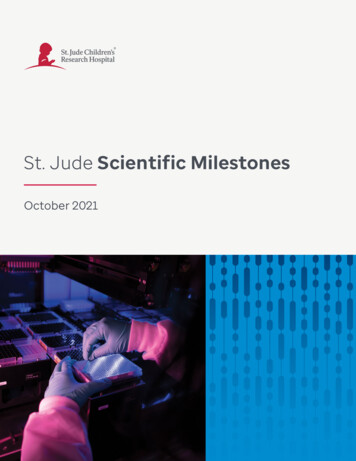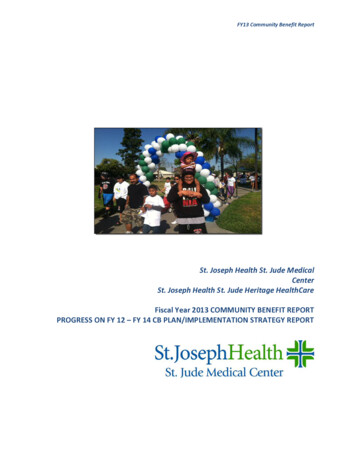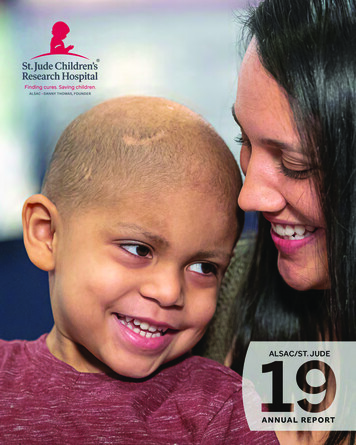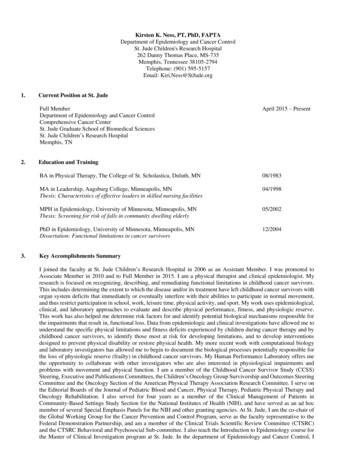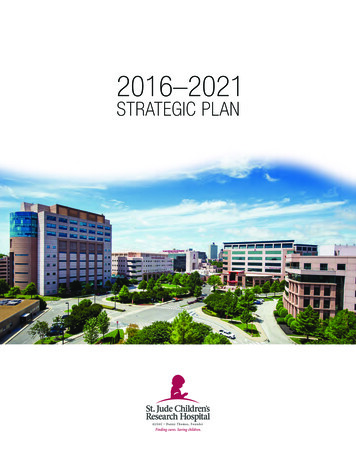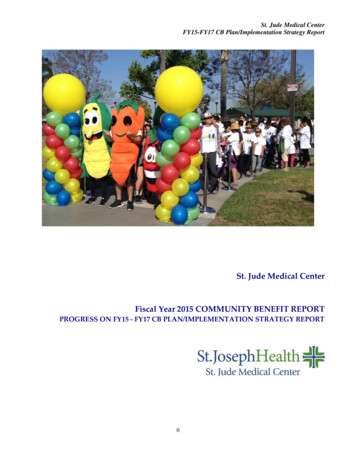
Transcription
St. Jude Medical CenterFY15-FY17 CB Plan/Implementation Strategy ReportSt. Jude Medical CenterFiscal Year 2015 COMMUNITY BENEFIT REPORTPROGRESS ON FY15 - FY17 CB PLAN/IMPLEMENTATION STRATEGY REPORT0
St. Jude Medical CenterFY15-FY17 CB Plan/Implementation Strategy ReportTABLE OF CONTENTSEXECUTIVE SUMMARY2MISSION, VISION AND VALUES2INTRODUCTION – WHO WE ARE AND WHY WE EXIST5ORGANIZATIONAL COMMITMENTCommunity Benefit Governance and Management Structure78PLANNING FOR THE UNINSURED AND UNDERINSURED9COMMUNITYDefining the Community10COMMUNITY NEEDS & ASSESTS ASSESSMENT PROCESS & RESULTSSummary of Community Needs and Assets Assessment Process and ResultsIdentification and Selection of DUHN CommunitiesPriority Community Health NeedsCOMMUNITY BENEFIT PLANNING PROCESSSummary of Community Benefit Planning Process172022Addressing the Needs of the Community:FY15- FY17 Key Community Benefit Initiatives and Evaluation Plan26Other Community Benefit Programs and Evaluation Plan34FY15 COMMUNITY BENEFIT INVESTMENTTelling Our Community Benefit Story:Non-Financial1 Summary of Accomplishments3738Governance approval391
St. Jude Medical CenterFY15-FY17 CB Plan/Implementation Strategy ReportEXECUTIVE SUMMARYOur MissionTo extend the healing ministry of Jesus in the tradition of the Sisters of St. Joseph of Orange bycontinually improving the health and quality of life of people in the communities we serve.Our VisionWe bring people together to provide compassionate care, promote health improvement and create healthycommunities.Our ValuesThe four core values of St. Joseph Health– Service, Excellence, Dignity and Justice – are the guidingprinciples for all we do, shaping our interactions with those whom we are privileged to serve.INTRODUCTIONWho We Are and Why We ExistAs a ministry founded by the Sisters of St. Joseph of Orange, St. Jude Medical Center lives outthe tradition and of community engagement set out hundreds of years ago. The Sisters of St.Joseph of Orange trace their roots back to 17th century France and the unique vision of a JesuitPriest names Jean-Pierre Medaille. He sought to organize an order of religious women who,rather than remaining cloistered in a convent, ventured out into the community to seek out“the Dear Neighbors” and minister to their needs. The congregation managed to survive theturbulence of the French revolution and eventually expanded not only throughout France butthroughout the world. In 1912 a small group of Sisters of St. Joseph went to Eureka, California,at the invitation of the local Bishop, to establish a school. A few years later, the great influenzaepidemic of 1918 caused the sisters to temporarily set aside their education efforts to care forthe ill. They realized immediately that the small community desperately needed a hospital.Through bold faith, foresight and flexibility in 1920, the Sisters opened the 28-bed St. JosephHospital Eureka and the first St. Joseph Health ministry.St. Joseph Health St. Jude Medical Center has been meeting the health and quality of life needsof North Orange County as part of St. Joseph Health Ministry since 1957. Serving thecommunities of Fullerton, Brea, Buena Park, La Habra, Placentia, Yorba Linda and thesurrounding areas, St. Jude Medical Center is a 351 acute care hospital that provides qualitycare in the areas of cardiac care, oncology, orthopedics, general surgery, rehabilitation,perinatal services, critical care, diagnostic imaging and emergency medicine. With the MedicalCenter’s 2,246 employees and 525 medical staff realizing the mission, St. Jude Medical Centeris one of the largest employers in the region. We are committed to increasing access to themost vulnerable through our charity care and community clinics, improving the health of our2
St. Jude Medical CenterFY15-FY17 CB Plan/Implementation Strategy Reportcommunity through prevention and disease management programs and working incollaboration with others to serve all residents in North Orange County with a special focus onthose living in poverty.Community Benefit InvestmentSt. Jude Medical Center invested 56,613,403 in community benefit in FY 2015 (FY15) a 16.9%increase from FY14 ( 48,449,534). For FY15, St. Jude Medical Center had an unpaid cost ofMedicare of 26,366,725 which represents a decrease in losses from the Medicare program as aresult of efforts to increase efficiency in managing Medicare patient care.Overview of Community Needs and Assets AssessmentThe FY15 priorities and programs were based on the findings of the FY14 SJMC NeedsAssessment. The process utilized in conducting the needs assessment included the following: PRC random telephonic survey of 750 households Orange County Health Care Agency Secondary Data Stakeholder surveys Community meetings with low income residents and representatives from agencies thatserve them.The Community 014isavailableonlineatCommunity Benefit Plan Priorities/Implementation StrategiesCommunity benefit priorities were developed in 2014 based on the 2014 Community HealthNeeds Assessment with input from community groups. FY15 priorities include: Increase Access to Medical Care for the Uninsured:We have provided 16,088 medical visits and 7,343 dental visits touninsured/underinsured low income persons through our affiliated fixed siteand mobile community clinic partnership with St. Jude Neighborhood HealthCenters, increasing access to care to individuals. We have increased access tospecialty care for the uninsured by recruiting additional volunteer specialists atour affiliated clinic, referrals to Heritage volunteer specialists and partneringwith Access OC to provide 30 free surgeries and colonoscopies at a SuperSurgery Saturday event.3
St. Jude Medical CenterFY15-FY17 CB Plan/Implementation Strategy Report Increase the percentage of 5th, 7th, and 9th graders in targeted schools in theHealthy Fitness Zone in body composition within our CBSA; strengthen city,school, and organizational policies that promote healthy lifestyles:We have implemented the Healthy Weight Initiative which addressedenvironmental, system and policy improvements in our community resulting in5 park fitness centers, 14 Fit Kid centers in schools, strengthened school wellnesspolicies reaching over 18,000 low income individuals. We continue to partnerwith Fullerton, Placentia, La Habra and Buena Park Collaboratives on theirObesity Prevention Plans. 22.6% of schools showed an increased percentage ofstudents in the Healthy Fitnesszone for Body Composition in FY 15 as comparedto FY 14. Enhance infant and child health through improved immunization rates:The immunization rate for Diphtheria, Tetanus and Pertussis (DTAP) vaccine atSt. Jude Neighborhood Health Centers increased from 36% to 70% and for St.Jude Heritage Medical Group increased from 48% to 79%, both exceeding target.The immunization rate for Measles, Mumps and Rubella (MMR) vaccine at St.Jude Neighborhood Health Centers increased from 73% to 88% and at St. JudeHeritage Medical Group from 86% to 93% both exceeding FY15 targets. Improve behavioral health in low-income populations though prevention andaccess:Both the St. Jude Neighborhood Health Center and St. Jude Heritage introducedbehavioral health screening tools in the primary care setting.St. JudeNeighborhood Health Center introduced the Staying Health Assessment and theStaying Healthy Assessment 50 which address mental health issues. St. JudeHeritage utilizes the PHQ-9 (Patient Health Questionnaire-9) for seniors and anattention deficit hyperactivity disorder (ADHD) assessment. The PositiveBehavioral Invention Supports (PBIS) program had 24 Title I schoolsparticipating in FY15 meeting the goal that was established.4
St. Jude Medical CenterFY15-FY17 CB Plan/Implementation Strategy ReportINTRODUCTIONWho We Are and Why We ExistAs a ministry founded by the Sisters of St. Joseph of Orange, St. Jude Medical Center lives outthe tradition and of community engagement set out hundreds of years ago. The Sisters of St.Joseph of Orange trace their roots back to 17th century France and the unique vision of a JesuitPriest names Jean-Pierre Medaille. He sought to organize an order of religious women who,rather than remaining cloistered in a convent, ventured out into the community to seek out“the Dear Neighbors” and minister to their needs. The congregation managed to survive theturbulence of the French revolution and eventually expanded not only throughout France butthroughout the world. In 1912 a small group of Sisters of St. Joseph went to Eureka, California,at the invitation of the local Bishop, to establish a school. A few years later, the great influenzaepidemic of 1918 caused the sisters to temporarily set aside their education efforts to care forthe ill. They realized immediately that the small community desperately needed a hospital.Through bold faith, foresight and flexibility in 1920, the Sisters opened the 28-bed St. JosephHospital Eureka and the first St. Joseph Health ministry.St. Joseph Health St. Jude Medical Center has been meeting the health and quality of life needsof North Orange County as part of St. Joseph Health Ministry since 1957. Serving thecommunities of Fullerton, Brea, Buena Park, La Habra, Placentia, Yorba Linda and thesurrounding areas, St. Jude Medical Center is a 351 acute care hospital that provides qualitycare in the areas of cardiac care, oncology, orthopedics, general surgery, rehabilitation,perinatal services, critical care, diagnostic imaging and emergency medicine. St. Jude MedicalCenter is one of the largest employers in the region. We are committed to increasing access tothe most vulnerable through our charity care and community clinics, improving the health ofour community through prevention and disease management programs and working incollaboration with others to serve all residents in North Orange County with a special focus onthose living in poverty.5
St. Jude Medical CenterFY15-FY17 CB Plan/Implementation Strategy ReportMission, Vision and Values and Strategic DirectionOur MissionTo extend the healing ministry of Jesus in the tradition of the Sisters of St. Joseph of Orangeby continually improving the health and quality of life of people in the communities we serve.Our VisionWe bring people together to provide compassionate care,promote health improvement and create healthy communities.Our ValuesThe four core values of St. Joseph Health -- Service, Excellence, Dignity and Justice -are the guiding principles for all we do, shaping our interactionswith those whom we are privileged to serve.St. Jude Medical Center has been meeting the health and quality of life needs of North OrangeCounty as part of St. Joseph Health Ministry since 1957. Serving the communities of Fullerton,Brea, Buena Park, La Habra, Placentia, Yorba Linda and the surrounding areas, St. JudeMedical Center is a 329 acute care hospital that provides quality care in the areas of cardiaccare, oncology, orthopedics, general surgery, rehabilitation, perinatal services, critical care,diagnostic imaging and emergency medicine. With the Medical Center’s 2,865 employees and740 medical staff realizing the mission, St. Jude Medical Center is one of the largest employersin the region. We are committed to increasing access to the most vulnerable through ourcharity care and community clinics, improving the health of our community throughprevention and disease management programs and working in collaboration with others toserve all residents in North Orange County with a special focus on those living in poverty.Strategic DirectionAs we move into the future, St. Jude Medical Center is committed to furthering our missionand vision while transforming healthcare to a system that is health-promoting and preventive,accountable in its inevitable rationing decisions, integrated across a balanced network of careand financed according to its ability to pay. To make this a reality, over the next five years(FY14-18), St. Joseph Health, St. Jude Medical Center is strategically focused on two key areasto which the Community Benefit Plan strongly align: population health management andnetwork of care.6
St. Jude Medical CenterFY15-FY17 CB Plan/Implementation Strategy ReportCommunity Benefit InvestmentSt. Jude Medical Center invested 56,613,403 in community benefit in FY 2015 (FY15) a 16.9%increase from FY14 ( 48,449,534). For FY15, St. Jude Medical Center had an unpaid cost ofMedicare of 26,366,725 which represents a decrease in losses from the Medicare program as aresult of efforts to increase efficiency in managing Medicare patient care.ORGANIZATIONAL COMMITMENTSt. Jude Medical Center dedicates resources to improve the health and quality of life for thecommunities it serves, with special emphasis on the needs of the economically poor andunderserved.In 1986, St. Joseph Health createdthe St. Joseph Health CommunityPartnership Fund (SJH CPF)(formerly known as the St. JosephHealth System Foundation) toimprove the health of ch year St. Jude Medical Centerallocates 10% of its net income (netunrealized gains and losses) to theSt. Joseph Health CommunityPartnership Fund. 7.5% of the contributions are used to support local hospital Care for thePoor programs. 1.75% is used to support SJH Community Partnership Fund grant initiatives.The remaining .75% is designated toward reserves, which helps ensure the Fund's ability tosustain programs into the future that assist low-income and underserved populationsFurthermore, St. Jude Medical Center will endorse local non-profit organization partners toapply for funding through the SJH Community Partnership Fund. Local non-profits thatreceive funding provide specific services and resources to meet the identified needs ofunderserved communities throughout St. Joseph Health hospitals’ service areas.7
St. Jude Medical CenterFY15-FY17 CB Plan/Implementation Strategy ReportCommunity Benefit Governance and Management StructureSt. Jude Medical Center demonstrates organizational commitment to the community benefitprocess through the allocation of staff time, financial resources, participation, andcollaboration. The Vice President of Healthy Communities, the Vice President of MissionIntegration, and the SJMC Community Benefit Committee of the Board of Trustees areresponsible for coordinating implementation of California Senate Bill 697 provisions as well asprovide the opportunity for community leaders, internal hospital Executive ManagementTeam members, physicians, and other staff to work together in planning and carrying out theCommunity Benefit Plan.The Community Benefit (CB) Management Team provides orientation for all new MedicalCenter employees on Community Benefit programs and activities, including opportunities forcommunity participation.A charter approved in 2007 establishes the formulation of the St. Jude Medical CenterCommunity Benefit Committee. The role of the Community Benefit Committee is to supportthe Board of Trustees in overseeing community benefit issues. The Committee acts inaccordance with a Board-approved charter. The Community Benefit Committee is chargedwith developing policies and programs that address identified needs in the service areaparticularly for underserved populations, overseeing development and implementation of theCommunity Health Needs Assessment and Community Benefit Plan/Implementation StrategyReports, and overseeing and directing the Community Benefit activities.The CB Committee has a minimum of eight members including three members of the Board ofTrustees. Current membership includes five members of the Board of Trustees and 11community members. A majority of members have knowledge and experience with thepopulations most likely to have disproportionate unmet health needs. Committee generallymeets quarterly.ROLES AND RESPONSIBILITIESSenior Leadership CEO and other senior leaders are directly accountable for CB performance.Community Benefit Committee (CBC) CBC serves as an extension of trustees to provide direct oversight for all charitableprogram activities and ensure program alignment with Advancing the State of the Art(ASACB) Five Core Principles. It includes diverse community stakeholders. Trusteemembers on CBC serve as ‘board level champions’8
St. Jude Medical CenterFY15-FY17 CB Plan/Implementation Strategy Report The committee provides recommendations to the Board of Trustees regarding budget,program targeting and program continuation or revision.Community Benefit Department Manages CB efforts and coordination between CB and Finance departments onreporting and planning. Manages data collection, program tracking tools and evaluation. Develops specific outreach strategies to access identified Disproportionate UnmetHealth Needs (DUHN) populations. Coordinates with clinical departments to reduce inappropriate ER utilization. Advocates for CB to senior leadership and invests in programs to reduce healthdisparities.Community Partnership to implement and sustain collaborative activities. Formal links with community partners. Recognition of priority health issue and collaborative activities to address it Engagement of local government officials in strategic planning and advocacy on healthrelated issues on a city, county, or regional level.PLANNING FOR THE UNINSURED AND UNDERINSUREDPatient Financial Assistance ProgramWe believe that no one should delay seeking needed medical care because they lack healthinsurance. That is why St. Joseph Health St. Jude Medical Center has a Patient FinancialAssistance Program (FAP) that provides free or discounted services to eligible patients. InFY15, St. Jude Medical Center provided 4,980,286 in charity care for 15,236 encounters, adecrease of 34 % from FY14. This is due to the increase in the number of insured in OrangeCounty as a result of the Affordable Care ActOne way St. Joseph Health, St. Jude Medical Center informs the public of FAP is by postingnotices. Notices are posted in high volume inpatient and outpatient service areas. Notices arealso posted at locations where patients may pay their bill. Notices include contact informationon how a patient can obtain more information on financial assistance as well as where to applyfor assistance. These notices are posted in English and Spanish and any other languages thatare representative of 5% or greater of patients in the hospital. All patients who demonstratelack of financial coverage by third party insurers are offered an opportunity to complete thePatient Financial Assistance application and are offered information, assistance, and referral togovernment sponsored programs for which they may be eligible. The Health System9
St. Jude Medical CenterFY15-FY17 CB Plan/Implementation Strategy Reportenhanced its process for determining charity care by adding an assessment for presumptivecharity care. This assessment uses a predictive model and public records to identify andqualify patients for charity care, without a traditional charity care application.MedicaidSt. Joseph Health St. Jude Medical Center provided access to uninsured and underinsured byparticipating in Medicaid, also known as Medi-Cal in California. In FY15, SJMC provided 46,632,168 in Medicaid shortfall, a 72.4% increase from FY 14. This increase is due in part tothe significant increase in the Medicaid population as a result of the Affordable Care Act andthe impact of the Hospital Fee ProgramCOMMUNITYDefining the CommunitySt. Jude Medical Center provides parts of Orange, Riverside, Los Angeles and San Bernardinocounties with access to advanced care and advanced caring. The hospital's total service areaextends from Walnut and Chino Hills in the north, Anaheim in the south, Corona in the eastand Whittier and La Mirada in the west. Our Hospital Total Service Area includes the cities ofAnaheim, Brea, Buena Park, Chino, Chino Hills, Corona, Diamond Bar, Fullerton, HaciendaHeights, La Habra, La Mirada, Placentia, Walnut, Whittier and Yorba Linda. This includes apopulation of approximately 1.61 million people, which is similar to the prior assessment. Thispopulation is ethnically diverse with 44.5% Hispanic and 19.3% Asian-Pacific Islander,youthful with 25.9% of the population under 17 years of age, and with both wealth andpoverty with 8.4% of households living below the federal poverty level. This area has some ofthe most densely population neighborhoods in California.The Medical Center has defined a Community Benefit Service Area since it began developingcommunity benefit plans more than fifteen years ago that focuses on the cities nearest thehospital, including: Brea, Buena Park, Fullerton, La Habra, Placentia,and Yorba Linda.The CBSA includes two areas designated as Medically Underserved Populations (MUPs) – onein south Fullerton and the other in La Habra. For a complete copy of St. Jude Medical Center’sFY14 CHNA go to: www.stjudemedicalcenter.org.10
St. Jude Medical CenterFY15-FY17 CB Plan/Implementation Strategy ReportHospital Total Service AreaThe community served by the Hospital is defined based on the geographic origins of theHospital’s inpatients. The Hospital Total Service Area is comprised of both the Primary ServiceArea (PSA) as well as the Secondary Service Area (SSA) and is established based on thefollowing criteria: PSA: 70% of discharges (excluding normal newborns) SSA: 71%-85% of discharges (draw rates per ZIP code are considered and PSA/SSA aremodified accordingly) Includes ZIP codes for continuity Natural boundaries are considered (i.e., freeways, mountain ranges, etc.) Cities are placed in PSA or SSA, but not bothThe Primary Service Area (“PSA”) is the geographic area from which the majority of theHospital’s patients originate. The Secondary Service Area (“SSA”) is where an additionalfifteen percent of the population of the Hospital’s inpatients reside. The PSA is comprised ofFullerton, Brea, La Habra, La Mirada, Diamond Bar, Rowland Heights, and Yorba Linda. TheSSA is comprised of another 8 cities including Walnut, Whittier, Hacienda Heights, BuenaPark, Anaheim, Chino Hills, Chino and Corona.Table 1. Cities and ZIP codes in Community Benefit Service AreaCitiesBreaBuena ParkFullertonLa HabraPlacentiaYorba LindaZIP ,92835906319287092886,9288711
St. Jude Medical CenterFY15-FY17 CB Plan/Implementation Strategy ReportFigure 1 depicts the Hospital’s PSA and SSA. It also shows the location of the Hospital as wellas the other hospitals in the area that are a part of St. Joseph Health.Figure 1: Hospital Total Service Area12
St. Jude Medical CenterFY15-FY17 CB Plan/Implementation Strategy ReportThe geographic area of focus in our community needs assessment and plan includes the sixcities in our Community Benefit Service Area (CBSA) of Brea, Buena Park, Fullerton, La Habra,Placentia, and Yorba Linda.Table 2 shows that there are wide disparities in economic indicators within the SJMC CBSA.Buena Park has the lowest median household income and the highest unemployment rate.Within each city, except Yorba Linda, there are neighborhoods that have a higher percentageof disproportionate unmet health needs populations.Table 2. Sociodemographic characteristics of communities in SJMC CBSA; Source: U.S.Census Bureau, 2010.Community Need Index (Zip Code Level) Based on National NeedThe Community Need Index (CNI) was developed by Dignity Health (formerly known asCatholic Healthcare West (CHW)) and Truven Health Analytics. The Community Needs Index(CNI) identifies the severity of health disparity for every zip code in the United States anddemonstrates the link between community need, access to care, and preventablehospitalizations.CNI aggregates five socioeconomic indicators that contribute to health disparity (also knownas barriers): Income Barriers (Elder poverty, child poverty and single parent poverty) Culture Barriers (non-Caucasian limited English) Educational Barriers (% population without HS diploma) Insurance Barriers (Insurance, unemployed and uninsured) Housing Barriers (Housing, renting percentage)13
St. Jude Medical CenterFY15-FY17 CB Plan/Implementation Strategy ReportThis objective measure is the combined effect of five socioeconomic barriers (income, culture,education, insurance and housing). A score of 1.0 indicates a zip code with the fewestsocioeconomic barriers, while a score of 5.0 represents a zip code with the most socioeconomicbarriers. Residents of communities with the highest CNI scores were shown to be twice aslikely to experience preventable hospitalizations for manageable conditions such as earinfections, pneumonia or congestive heart failure compared to communities with the lowestCNI scores. (Ref (Roth R, Barsi E., Health Progress. 2005 Jul-Aug; 86(4):32-8.) The CNI is used to adraw attention to areas that need additional investigation so that health policy and planningexperts can more strategically allocate resources.For example, the ZIP code 92832 on the CNI map is scored 4.4, making it and zip code 90620 at4.4 the High Need communities in our CBSA.Figure 2 depicts the Community Need Index for the hospital’s geographic service area basedon national need. It also shows the location of the Hospital and the affiliated community clinic.Figure 2. St. Jude Medical Center Community Need Index Map.14
St. Jude Medical CenterFY15-FY17 CB Plan/Implementation Strategy ReportIntercity Hardship Index (Block group level) Based Geographic NeedThe Intercity Hardship Index (IHI) was developed in 1976 by the Urban and MetropolitanStudies Program of the Nelson A. Rockefeller Institute of Government to reflect the economiccondition of cities and allow comparison across cities and across time. The IHI ranges from 0100, with a higher number indicating greater hardship. The IHI was used by St. Joseph Healthto identify block groups with the greatest need.The IHI combines six key social determinants that are often associated with health outcomes:1) Unemployment (the percent of the population over age 16 that is unemployed)2) Dependency (the percent of the population under the age of 18 or over the age of 64)3) Education (the percent of the population over age 25 who have less than a high schooleducation)4) Income level (per capita income)5) Crowded housing (percent of households with seven or more people)6) Poverty (the percent of people living below the federal poverty level)Based on the IHI, each block group was assigned a score from 1 (lowest IHI, lowest level ofhardship/need) to 5 (highest IHI, highest level of hardship/need). The IHI is based on relativeneed within a geographic area, allowing for comparison across areas. Similar to what is seenwith the Community Need Index; the highest need areas are in the cities of Placentia, La Habraand Fullerton.15
St. Jude Medical CenterFY15-FY17 CB Plan/Implementation Strategy ReportFigure 3 depicts the Intercity Hardship Index for Orange County’s geographic service area anddemonstrates relative need.Figure 3. Orange County Intercity Hardship Index (Block group Level)16
St. Jude Medical CenterFY15-FY17 CB Plan/Implementation Strategy ReportCOMMUNITY NEEDS ASSESSMENT PROCESS AND RESULTSSummary of the Community Needs and Assets Assessment ProcessSt. Jude Medical Center completed a needs assessment in FY 2014. This Community HealthAssessment is a follow-up to the study conducted in 2007 and our 2010 Assessment. It is asystematic, data-driven approach to determining the health status, behaviors and lifestyles ofresidents in our Community Benefit Service Area (CBSA). This Community HealthAssessment serves as a tool toward reaching three basic goals:1. To improve community residents’ self-reported health status, functional health, andoverall quality of life.2. To reduce the health disparities among residents.3. To increase accessibility to preventive services for all community residents.The process utilized in the community health needs assessment is outlined in Figure 4.Figure 4. FY14 Community Benefit Planning Process17
St. Jude Medical CenterFY15-FY17 CB Plan/Implementation Strategy ReportThe assessment incorporates primary source data conducted by Professional ResearchConsultants, Inc. (PRC) in 2012 with comparison data from 2007, census data, community needindex data, and intercity hardship data. In addition, qualitative obtained through a keyinformant survey of community based organizations, foundations, health advocates,community clinics, local political/policy leaders, public health organizations, and otherhospitals.A variety of existing (secondary) data sources were consulted to complement the researchquality of this Community Health Assessment, including but not limited to: the 2010 U.S.Census, Orange County Healthy People Healthy Places Report, the Centers for DiseaseControl and Prevention (CDC), Orange County Health Needs Assessment Data, and keyinformant surveys and focus groups (involving community members, community leaders,public health experts, key stakeholders, low-income residents in North Orange County).National and statewide risk factor data were used as an additional benchmark against whichto compare local findings. Data sources include: Behavioral Risk Factor Surveillance System(BRFSS), Centers for Disease Control and Prevention (CDC), National Center for HealthStatistics (NCHS), National Health and Nutrition Examination Survey (NHANES), andCalifornia Departments of Health Services. The assessment also included consideration ofexisting assets available in the community to address health needs.St. Joseph Health, St. Jude Medical Center anticipates that implementation strategies maychange and therefore, a flexible approach is best suited for the development of its response tothe St. Joseph Health, St. Jude Medical Center CHNA. For example, certain community healthneeds may become more pronounced and re
St. Jude Medical Center invested 56,613,403 in community benefit in FY 2015 (FY15) a 16.9% increase from FY14 ( 48,449,534). For FY15, St. Jude Medical Center had an unpaid cost of Medicare of 26,366,725 which represents a decrease in losses from the Medicare program as a result of efforts to increase efficiency in managing Medicare patient care.
